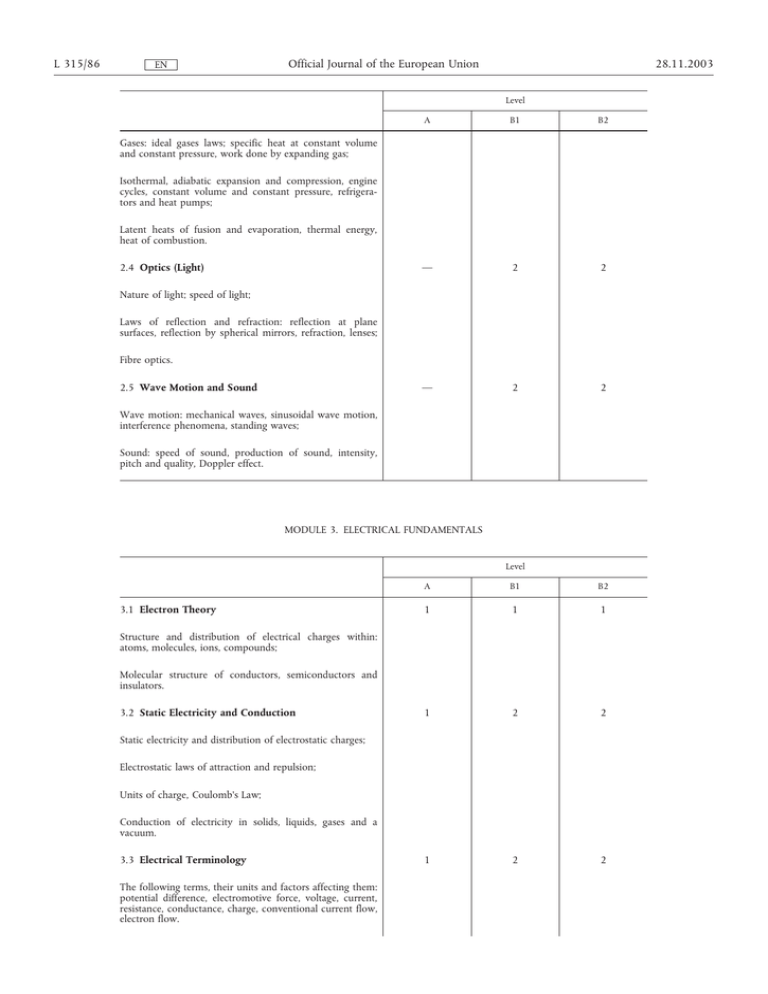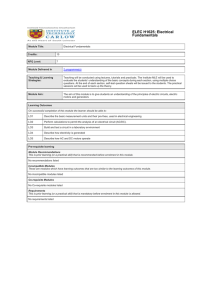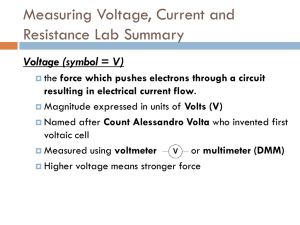28.11.2003 L 315/86 Official Journal of the European Union
advertisement

L 315/86 EN Official Journal of the European Union 28.11.2003 Level A B1 B2 — 2 2 — 2 2 Gases: ideal gases laws; specific heat at constant volume and constant pressure, work done by expanding gas; Isothermal, adiabatic expansion and compression, engine cycles, constant volume and constant pressure, refrigerators and heat pumps; Latent heats of fusion and evaporation, thermal energy, heat of combustion. 2.4 Optics (Light) Nature of light; speed of light; Laws of reflection and refraction: reflection at plane surfaces, reflection by spherical mirrors, refraction, lenses; Fibre optics. 2.5 Wave Motion and Sound Wave motion: mechanical waves, sinusoidal wave motion, interference phenomena, standing waves; Sound: speed of sound, production of sound, intensity, pitch and quality, Doppler effect. MODULE 3. ELECTRICAL FUNDAMENTALS Level 3.1 Electron Theory A B1 B2 1 1 1 1 2 2 1 2 2 Structure and distribution of electrical charges within: atoms, molecules, ions, compounds; Molecular structure of conductors, semiconductors and insulators. 3.2 Static Electricity and Conduction Static electricity and distribution of electrostatic charges; Electrostatic laws of attraction and repulsion; Units of charge, Coulomb's Law; Conduction of electricity in solids, liquids, gases and a vacuum. 3.3 Electrical Terminology The following terms, their units and factors affecting them: potential difference, electromotive force, voltage, current, resistance, conductance, charge, conventional current flow, electron flow. 28.11.2003 EN Official Journal of the European Union L 315/87 Level 3.4 Generation of Electricity A B1 B2 1 1 1 1 2 2 — 2 2 — 2 2 — 1 1 Production of electricity by the following methods: light, heat, friction, pressure, chemical action, magnetism and motion. 3.5 DC Sources of Electricity Construction and basic chemical action of: primary cells, secondary cells, lead acid cells, nickel cadmium cells, other alkaline cells; Cells connected in series and parallel; Internal resistance and its effect on a battery; Construction, materials and operation of thermocouples; Operation of photo-cells. 3.6 DC Circuits Ohms Law, Kirchoff's Voltage and Current Laws; Calculations using the above laws to find resistance, voltage and current; Significance of the internal resistance of a supply. 3.7 Resistance/Resistor (a) Resistance and affecting factors; Specific resistance; Resistor colour code, values and tolerances, preferred values, wattage ratings; Resistors in series and parallel; Calculation of total resistance using series, parallel and series parallel combinations; Operation and use of potentiometers and rheostats; Operation of Wheatstone Bridge. (b) Positive and negative temperature coefficient conductance; Fixed resistors, stability, tolerance and limitations, methods of construction; Variable resistors, thermistors, voltage dependent resistors; Construction of potentiometers and rheostats; Construction of Wheatstone Bridge; L 315/88 EN Official Journal of the European Union 28.11.2003 Level 3.8 Power A B1 B2 — 2 2 — 2 2 — 2 2 — 2 2 Power, work and energy (kinetic and potential); Dissipation of power by a resistor; Power formula; Calculations involving power, work and energy. 3.9 Capacitance/Capacitor Operation and function of a capacitor; Factors affecting capacitance area of plates, distance between plates, number of plates, dielectric and dielectric constant, working voltage, voltage rating; Capacitor types, construction and function; Capacitor colour coding; Calculations of capacitance and voltage in series and parallel circuits; Exponential charge and discharge of a capacitor, time constants; Testing of capacitors. 3.10 Magnetism (a) Theory of magnetism; Properties of a magnet; Action of a magnet suspended in the Earth's magnetic field; Magnetisation and demagnetisation; Magnetic shielding; Various types of magnetic material; Electromagnets construction and principles of operation; Hand clasp rules to determine: magnetic field around current carrying conductor. (b) Magnetomotive force, field strength, magnetic flux density, permeability, hysteresis loop, retentivity, coercive force reluctance, saturation point, eddy currents; Precautions for care and storage of magnets. 28.11.2003 Official Journal of the European Union EN L 315/89 Level 3.11 Inductance/Inductor A B1 B2 — 2 2 — 2 2 1 2 2 Faraday's Law; Action of inducing a voltage in a conductor moving in a magnetic field; Induction principles; Effects of the following on the magnitude of an induced voltage: magnetic field strength, rate of change of flux, number of conductor turns; Mutual induction; The effect the rate of change of primary current and mutual inductance has on induced voltage; Factors affecting mutual inductance: number of turns in coil, physical size of coil, permeability of coil, position of coils with respect to each other; Lenz's Law and polarity determining rules; Back emf, self induction; Saturation point; Principle uses of inductors; 3.12 DC Motor/Generator Theory Basic motor and generator theory; Construction and generator; purpose of components in DC Operation of, and factors affecting output and direction of current flow in DC generators; Operation of, and factors affecting output power, torque, speed and direction of rotation of DC motors; Series wound, shunt wound and compound motors; Starter Generator construction. 3.13 AC Theory Sinusoidal waveform: phase, period, frequency, cycle; Instantaneous, average, root mean square, peak, peak to peak current values and calculations of these values, in relation to voltage, current and power Triangular/Square waves; Single/3 phase principles. L 315/90 EN Official Journal of the European Union 28.11.2003 Level 3.14 Resistive (R), Capacitive (C) and Inductive (L) Circuits A B1 B2 — 2 2 — 2 2 — 1 1 — 2 2 — 2 2 Phase relationship of voltage and current in L, C and R circuits, parallel, series and series parallel; Power dissipation in L, C and R circuits; Impedance, phase angle, power factor and current calculations; True power, apparent power and reactive power calculations. 3.15 Transformers Transformer construction principles and operation; Transformer losses and methods for overcoming them; Transformer action under load and no-load conditions; Power transfer, efficiency, polarity markings; Calculation of line and phase voltages and currents; Calculation of power in a three phase system; Primary and Secondary current, voltage, turns ratio, power, efficiency; Auto transformers. 3.16 Filters Operation, application and uses of the following filters: low pass, high pass, band pass, band stop. 3.17 AC Generators Rotation of loop in a magnetic field and waveform produced; Operation and construction of revolving armature and revolving field type AC generators; Single phase, two phase and three phase alternators; Three phase star and delta connections advantages and uses; Permanent Magnet Generators. 3.18 AC Motors Construction, principles of operation and characteristics of: AC synchronous and induction motors both single and polyphase; Methods of speed control and direction of rotation; Methods of producing a rotating field: capacitor, inductor, shaded or split pole.







